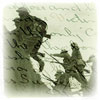Warrant Officer Stuart Marshall Cross was born on January 21, 1920, in Verdun, Québec. In 1934 he moved with his family to St. Andrews, Scotland. Prior to World War II he worked as an insurance clerk.
Cross joined Britain’s Royal Air Force in August 1940. In December 1941, with R.A.F. 15 Operational Training Unit, Cross was flying as second pilot in Wellington IC DV416, when a fuel shortage forced an emergency landing near Catania, Italy. All of the aircrew were captured as Italian prisoners of war. In September 1943 Cross escaped from P.O.W. Camp 59 (Servigliano). After many months spent in hiding, he successfully connected up with British forces the following June, and returned to England in July 1944. Cross continued to serve in the R.A.F. after the war.
R.A.F. aircrew flying with Cross on December 28, 1941: Sgt. Edward Ronald Ashton (1282755), F/O Samuel Beckett (106061), Sgt. Robert Charles Davis (644393), Sgt. Ronald Percy Holmes (1375674), and Sgt. Robert Veitch (1107337). All were captured as Prisoners of War; Holmes was later shot and killed following his escape from a detention camp in February 1944.
Stuart Cross’s sister Wilma also served during the Second World War. Photographs from her time with the Canadian Women’s Army Corps are held in the Wilma Cross Collection.
Content notes:
The collection’s letters and telegrams date from late 1941 to early 1942, and pertain to Cross’s status as missing/P.O.W. The January 1942 letter was written by Cross to his parents less than a week after his capture as a P.O.W.
External links:
W/O Stuart Cross’s British service record (Serv/Reg# 1051162) is not available for public access; his P.O.W. Escape Report is held by the British National Archives under reference code WO 208/3320/91.




